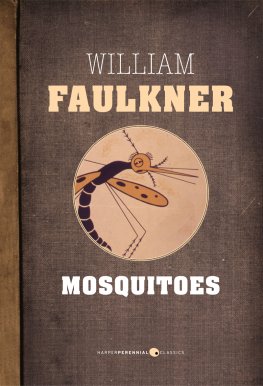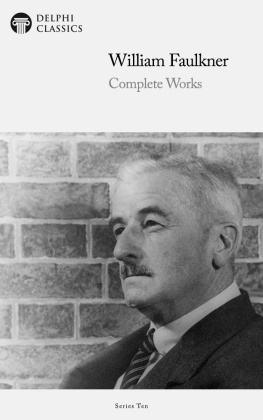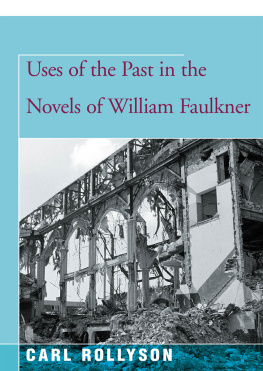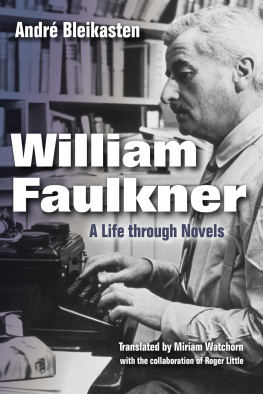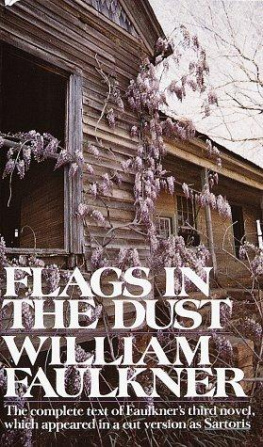In the mid-seventies, Robert Penn Warren urged me, on one of our regular hikes through the Vermont woods near Mount Stratton, to take on Faulkner. He suggested that the deeper I got into his work, the more I would find out about him and myself as well. This book represents a particular journey, a series of discoveries, an attempt to reach through Faulkner to find him in his work, the work in him, without reading crassly backward from the work into the life. One can only read forward from his books, seeing things in the circumstances of their production that help to explain their nature and form.
Despite some thirty years of reading Faulkner and discussing his books with students at Dartmouth and Middlebury, I still had many questions about him and his books. This biographical study represents an effort to understand how the whole of Faulkners project hangs together, what it meant for him to invent himself as a southern writer of universal significance, and how regiondeeply, instinctivelyplayed into the production of his fiction, with its fluid boundaries and seamless textuality. My hope was to write a book for the general reader that would ground Faulkners work in his daily life, in the conditions from which the novels and stories arose, and to examine the work itself in a straightforward way, taking into account a wide range of critical voices over the past fifty years.
The reader will find scattered through these pages bits of interviews I have conducted over the past decades, wherein the conversation often turned to Faulkner. In addition to Warren, there are comments here from Cleanth Brooks, Gore Vidal, Graham Greene, Elaine Steinbeck, Mario Vargas Llosa, Alastair Reid, Alberto Moravia, and others. I also talked to people who knew Faulkner personally, including his daughter, Jill Faulkner Summers, and others, such as Joan Williams and Jean Stein. In a sense, I also listened in on Faulkners long conversations with relatives and friends, as recorded in his voluminous correspondence, which is mostly housed at the University of Virginias Alderman Library, where I had the benefit of help from Michael Plunkett, curator of the William Faulkner Foundation Collection. Im also grateful to the Harry Ransom Humanities Research Center at the University of Texas at Austin and the John Davis Williams Library at the University of Mississippi, Oxford.
Needless to say, a biographer and critic of Faulkner is heavily indebted to Joseph Blotner, who wrote an impressive, foundational biography of Faulkner in the early seventies. I have repeatedly turned to Blotners work, and have tried to cite him regularly, but my debt to his book is profound, and I want here to acknowledge that I, like everyone who writes on Faulkner, am grateful to him for establishing the primary facts and chronology in the life of Faulkner and framing the discussion in intelligent ways. I have also relied on his fine edition of Faulkners letters. In addition, Im grateful to Richard Gray, Frederick R. Karl, and David Minter; their biographical studies helped me with my work, and they are useful for anyone wishing to apprehend Faulkners life in any detail. Joel Williamsons study of Faulkners southern background is remarkable for its clarity and detail, and I was grateful to have this book on hand. Among numerous critics (cited in the bibliography) who proved essential to my work were Philip M. Weinstein, Noel Polk, John T. Matthews, Donald M. Kartiganer, Andr Bleikasten, Karl F. Zender, Thomas L. McHaney, James G. Watson, Kevin Railey, Daniel J. Singal, and Judith L. Sensibar. I am also indebted to Don H. Doyle for his excellent study of the background of Yoknapatawpha County. Finally, I found myself repeatedly checking facts in two excellent reference works: William Faulkner: A to Z , by A. Nicholas Fargnoli and Michael Golay, and A William Faulkner Encyclopedia , edited by Robert W. Hamblin and Charles A. Peek. Countless other critics and scholars proved useful at various points in this work, and they are listed in the bibliography or cited in footnotes.
This book is the product of many conversations about Faulkner over several decades, mostly with my students but also with friends and colleagues. I wish I could remember who said what, and when, but that isnt possible. Certainly Pauls Toutonghi gave me lots of wonderful suggestions, as did Philip M. Weinstein and Noel Polk, to whom I am eternally grateful for their willingness to read this biography in draft and make suggestions. John B. Padgett helped me with the photographs, and I thank him for this assistance. While working at the Alderman Library, I was hosted by Ann Beattie and Lincoln Perry: close friends, always. Charles and Holly Wright also helped to make my visits to Charlottesville a pleasure, and Im grateful for their friendship. Im indebted to Laura Starrett for her meticulous job of copyediting, which vastly improved this manuscript. I also must thank my wife, Devon Jersild, always a stringent and intelligent reader, and my editor, Terry Karten, whose constant support and energetic mind have been invaluable from the outset. Any errors or misjudgments found in these pages are my responsibility, of course. I hope they are few.
A Sense of Place
The past is never dead. Its not even past.
F AULKNER , Requiem for a Nun
A sense of place was everything to William Faulkner, and more than any other American novelist in the twentieth century, he understood how to mine the details of place, including its human history, for literary effects. His novels, from the outset, are obsessed with what T. S. Eliot once referred to as significant soil, but the outward details of place quickly become inner details as Faulkner examines the soul of his characters through the prism of their observations, their rootings and branchings, their familial and social as well as geographical contexts. Place, for Faulkner, becomes a spiritual location from which he examines a truth deeper than anything like mere locality. Faulkner saw himself as taking part in a great process, moving through history and, in an intriguing way, creating a counterhistory of his own.
He would focus in his fiction on a parallel universe based on the real universe of Lafayette County, Mississippi. Faulkners invented region, Yoknapatawpha County, was named after an actual stream that ran through Lafayette County, the name itself meaning, according to Faulkner, the water runs slow through flat land. Lafayette was among several counties created by various acts of violence in northern Mississippi in the 1830s, when the native Chickasaw tribe was driven westward, displaced by a procession of planters, slaves, and small farmers, all of whom worked together to fashion an economy based on cotton. At least for a whilebefore repeated plantings of cotton depleted the topsoilthis economy worked well for the white population of Lafayette, especially those living at its middle and higher end. Not surprisingly, this prosperous class regarded the abolition of slavery as a threat to their way of life and joined forces with those who believed in secession.
Their allegiance to the Old South was, for the most part, unwavering. In Faulkners fiction, the Sartoris clan would stand in for this class, the planter class, and their failure over generations is one of his most compelling themes, counterpointed by the implacable emergence of the Snopes clan, representing the greedy, unscrupulous white folks who come from the outlying country and who form a kind of counterpoint to the Sartoris clan, although it is somewhat misleading to regard this dialectic in a simplistic fashion, since there are admirable Snopeses and selfish, inconsiderate members of the Sartoris family.





